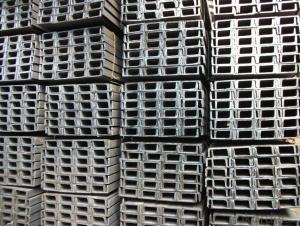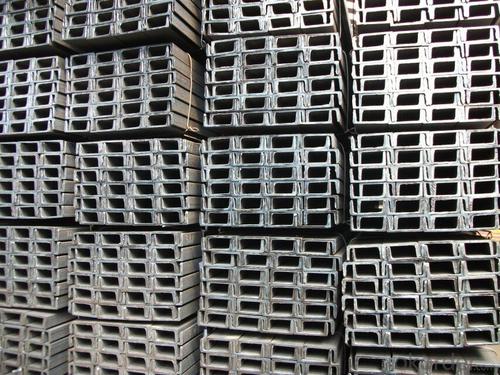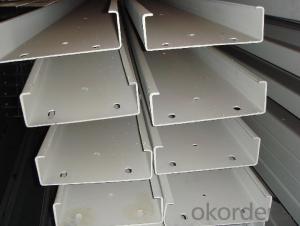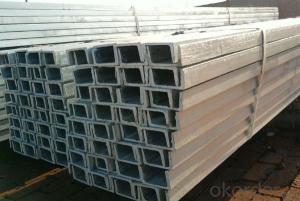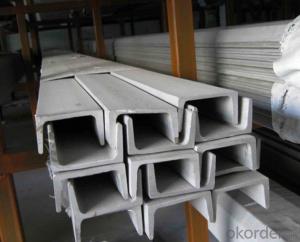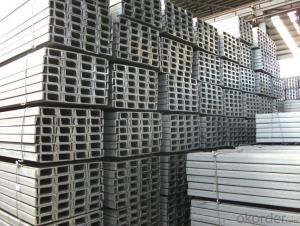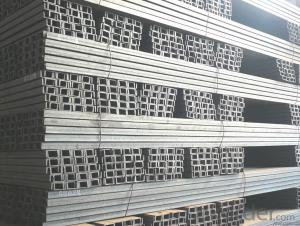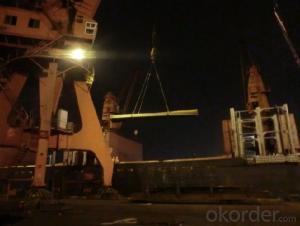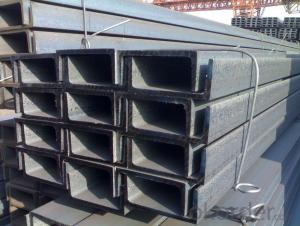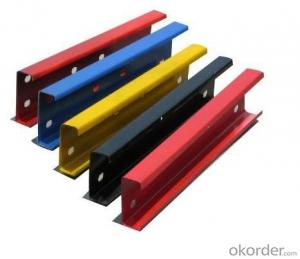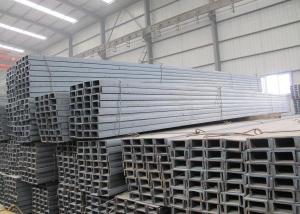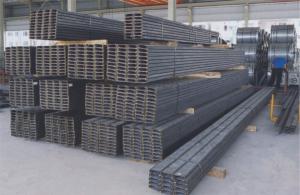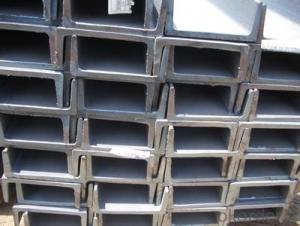New Arrival U Channel Steel to Africa Market
- Loading Port:
- Tianjin
- Payment Terms:
- TT OR LC
- Min Order Qty:
- 25 m.t.
- Supply Capability:
- 5000 m.t./month
OKorder Service Pledge
OKorder Financial Service
You Might Also Like
Specification
high quality Hot Rolled Steel U Beam at great prices with worldwide shipping. Our supplier is a world-class manufacturer of steel, with our products utilized the world over. OKorder annually supplies products to European, North American and Asian markets. We provide quotations within 24 hours of receiving an inquiry and guarantee competitive prices.
We supply high quality MS Channel at reasonable price, including Chinese standard, Japanese standard and so on.
Standard | GB/JIS |
Material Grade | Q235,SS400 |
Technique: | Hot Rolled |
Sizes as per chinese standard: | 50*37*4.5mm - 300*89*11.5mm |
Sizes as per japanese standard: | 50*25*3mm – 200*80*7.5mm |
Length: | 6meter, 9meter, 12meter |
Product Applications:
Hot Rolled Steel U-Beams are ideal for structural applications and are widely used in the construction of buildings and bridges, and the manufacturing, petrochemical, and transportation industries.
Product Advantages:
OKorder's Steel U-Beams are durable, strong, and resist corrosion.
Main Product Features:
· Premium quality
· Prompt delivery & seaworthy packing (30 days after receiving deposit)
· Corrosion resistance
· Can be recycled and reused
· Mill test certification
· Professional Service
· Competitive pricing
Product Specifications:
Manufacture: Hot rolled
Grade: Q195 – 235
Certificates: ISO, SGS, BV, CIQ
Length: 6m – 12m, as per customer request
Packaging: Export packing, nude packing, bundled


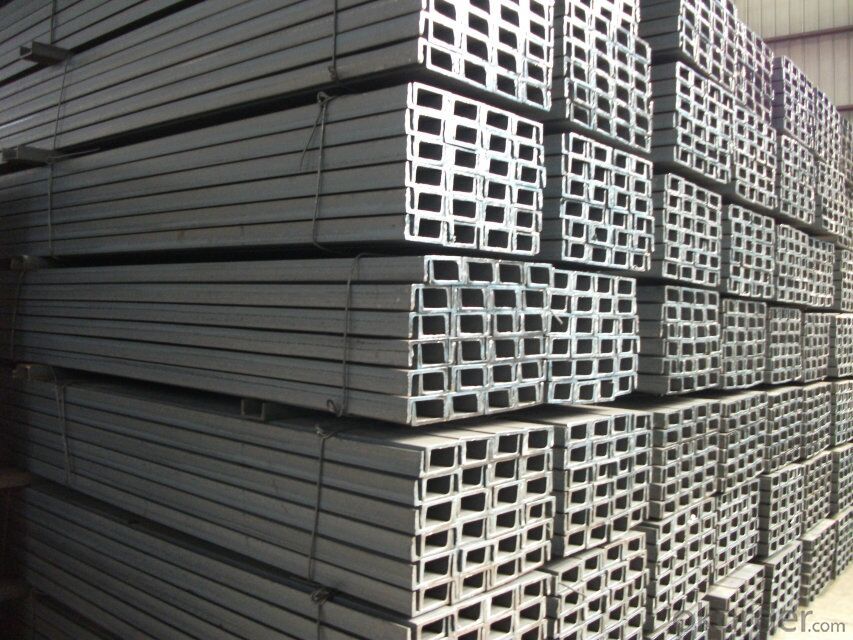
- Q: What are the different applications of steel channels in the automotive industry?
- Steel channels are widely used in the automotive industry due to their various applications and benefits. Here are some of the different applications of steel channels in the automotive industry: 1. Structural Support: Steel channels are commonly used for structural support in automobile frames, chassis, and body panels. They provide strength and rigidity to support the weight of the vehicle and absorb impact forces during collisions. 2. Reinforcement: Steel channels are used to reinforce critical areas of the vehicle, such as door frames, pillars, and roof rails. They enhance the structural integrity and safety of the vehicle, especially in the event of a crash. 3. Suspension Components: Steel channels are utilized in the manufacturing of suspension components like control arms, sway bars, and trailing arms. These components provide stability, control, and smooth ride quality by connecting the wheels to the chassis. 4. Bumper Reinforcements: Steel channels are incorporated into the design of bumper reinforcements to enhance impact resistance and protect both the vehicle and occupants in case of a collision. They distribute and absorb energy during an impact, minimizing damage. 5. Exhaust Systems: Steel channels are utilized in exhaust systems to create the necessary channeling for the exhaust gases to exit the vehicle. These channels are designed to withstand heat, vibrations, and corrosion caused by the exhaust gases. 6. Seat Frames: Steel channels are commonly used in the construction of seat frames, providing strength and durability. They ensure the seats remain secure and stable, offering comfort and safety to the occupants. 7. Roll Cages: Steel channels are employed in the fabrication of roll cages, which are critical safety features in racing vehicles. Roll cages provide protection to the driver in the event of a rollover or crash, preventing the roof from collapsing. In summary, steel channels play a crucial role in the automotive industry, contributing to the strength, safety, and performance of vehicles. Their applications range from structural support and reinforcement to suspension components, bumper reinforcements, exhaust systems, seat frames, and roll cages.
- Q: Can steel channels be recycled?
- Yes, steel channels can be recycled. Steel is a highly recyclable material and can be continuously reused without losing its properties or strength. When steel channels reach the end of their useful life, they can be collected, sorted, and sent to recycling facilities. The recycling process involves melting the steel channels down to remove impurities, and then reshaping the molten steel into new channels or other steel products. This recycling process not only helps conserve natural resources but also reduces the energy consumption and emissions associated with producing new steel. Therefore, recycling steel channels is an environmentally responsible choice that contributes to a more sustainable future.
- Q: Can steel channels be used for creating partitions or dividers?
- Yes, steel channels can be used for creating partitions or dividers. They provide structural support and can be easily installed to create separate spaces within a larger area. Steel channels offer durability and strength, making them suitable for dividing spaces in various settings such as industrial facilities, warehouses, offices, and residential spaces.
- Q: Can steel channels be used for window lintels?
- Yes, steel channels can be used for window lintels. Steel channels are strong and durable, making them suitable for supporting the weight of a window lintel. They provide structural support and help distribute the weight evenly, preventing any potential sagging or cracking. Additionally, steel channels can be customized to fit the specific dimensions required for the window lintel, ensuring a precise and secure fit. Overall, using steel channels for window lintels is a common and effective choice in construction and building projects.
- Q: Are steel channels suitable for structural applications?
- Certainly, structural applications can indeed make use of steel channels. In the construction industry, steel channels are frequently employed for their robustness and longevity. They possess remarkable load-bearing capacities, making them well-suited for accommodating substantial weights and spanning extensive distances. Moreover, steel channels exhibit commendable resistance against bending and twisting forces, thereby bolstering their structural integrity. Furthermore, steel channels can be conveniently manufactured and joined through welding, which grants a multitude of design options. Ultimately, steel channels provide a dependable and economically viable option for a wide array of structural applications, encompassing building frames, bridges, and industrial structures.
- Q: How do steel channels contribute to the overall stability of a bridge?
- Steel channels contribute to the overall stability of a bridge by providing structural support and distributing loads. These channels are often used as beams or columns in bridge construction, helping to transfer the weight of the bridge and the traffic it carries to the foundations. Their shape and design allow them to resist bending and twisting forces, enhancing the bridge's ability to withstand various loads and external factors, thereby ensuring its overall stability.
- Q: How do steel channels perform under static loads?
- Steel channels perform exceptionally well under static loads. Due to their structural properties and high strength-to-weight ratio, steel channels effectively distribute the load and maintain their shape, ensuring stability and minimal deformation. They can withstand significant weight and pressure without compromising their integrity, making them a reliable choice for various construction and engineering applications.
- Q: Can steel channels be used for curtain wall framing?
- Indeed, curtain wall framing can utilize steel channels. Due to their robustness and endurance, steel channels find frequent application in curtain wall systems. They furnish structural reinforcement and possess the capacity to endure the burden and stress exerted by the curtain wall system. Steel channels possess adaptability and can be tailored to match the precise specifications and measurements of the curtain wall. Moreover, the fabrication and installation of steel channels are hassle-free, rendering them a favored option for curtain wall framing.
- Q: Can steel channels be used for signpost installations?
- Indeed, signpost installations can make use of steel channels. In construction and engineering ventures, steel channels are frequently employed owing to their robustness, endurance, and adaptability. They furnish a robust support framework for diverse applications, including signpost installations. Steel channels possess the ability to endure environmental elements like wind, rain, and fluctuations in temperature, thereby rendering them suitable for outdoor utilization. Furthermore, their inflexibility guarantees the signpost's stability and security. Overall, steel channels represent an outstanding option for signpost installations, proffering enduring support and dependability.
- Q: Can steel channels be used for supporting HVAC systems?
- Indeed, the utilization of steel channels for the support of HVAC systems is feasible. These steel channels are typically constructed from robust and resilient steel materials, rendering them suitable for furnishing structural support to HVAC equipment. They are frequently employed in conjunction with other supporting materials, such as brackets and hangers, in order to firmly hold and suspend HVAC units, ductwork, and piping. Steel channels offer numerous advantages when it comes to supporting HVAC systems. Primarily, they possess a substantial load-bearing capacity, guaranteeing adequate support for the weight of HVAC equipment and components. Additionally, steel channels are resistant to corrosion and can endure harsh environmental conditions, making them suitable for both indoor and outdoor applications. Moreover, steel channels provide flexibility in terms of installation. They can be effortlessly adjusted and tailored to accommodate various configurations of HVAC systems. Furthermore, steel channels can be installed using a variety of methods, including welding, bolting, or clamping, thereby offering versatility during the installation process. It is of utmost importance to ensure that the steel channels used for supporting HVAC systems are designed and installed in accordance with industry standards and local building codes. Proper engineering and design considerations, such as load calculations, seismic requirements, and thermal expansion, must be taken into account to ensure the safety and stability of the HVAC system. In summary, steel channels are a dependable and commonly employed means of supporting HVAC systems, providing strength, durability, and flexibility in installation.
Send your message to us
New Arrival U Channel Steel to Africa Market
- Loading Port:
- Tianjin
- Payment Terms:
- TT OR LC
- Min Order Qty:
- 25 m.t.
- Supply Capability:
- 5000 m.t./month
OKorder Service Pledge
OKorder Financial Service
Similar products
Hot products
Hot Searches
Related keywords
